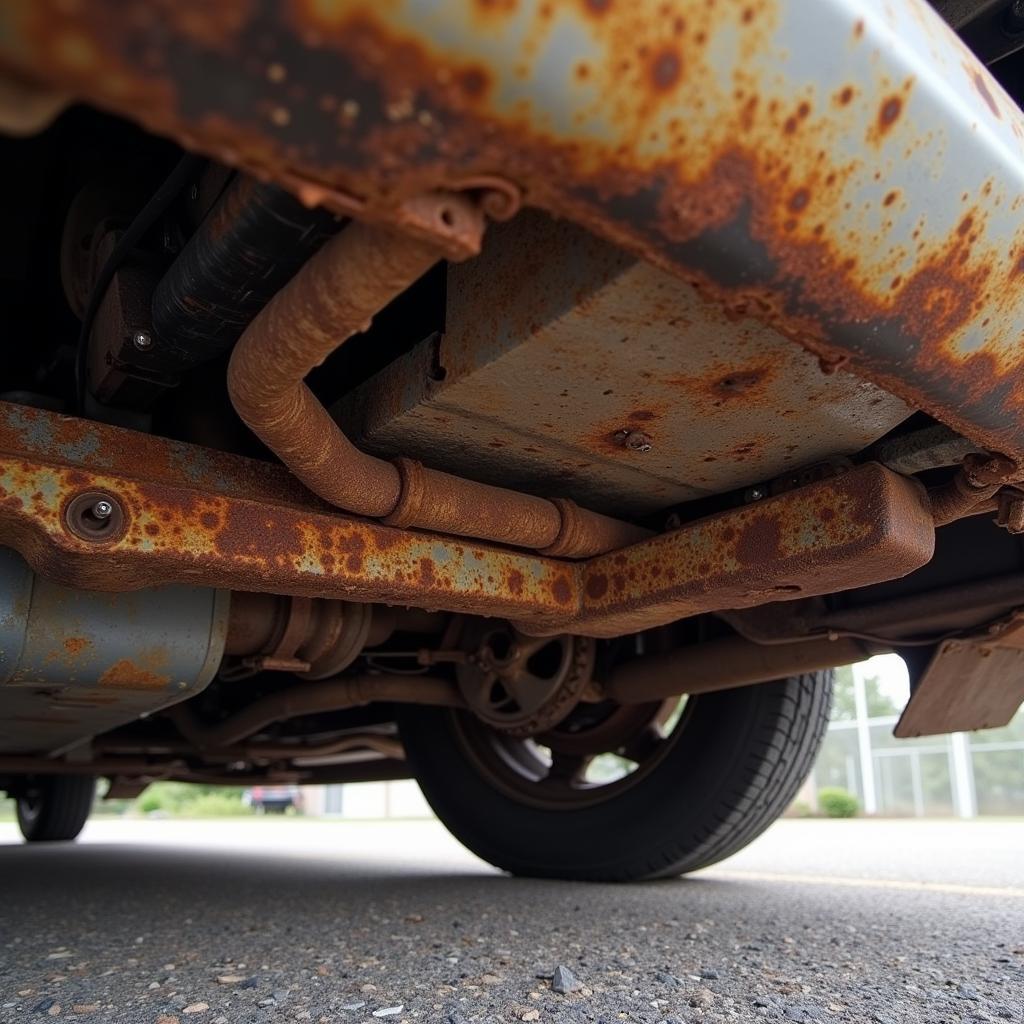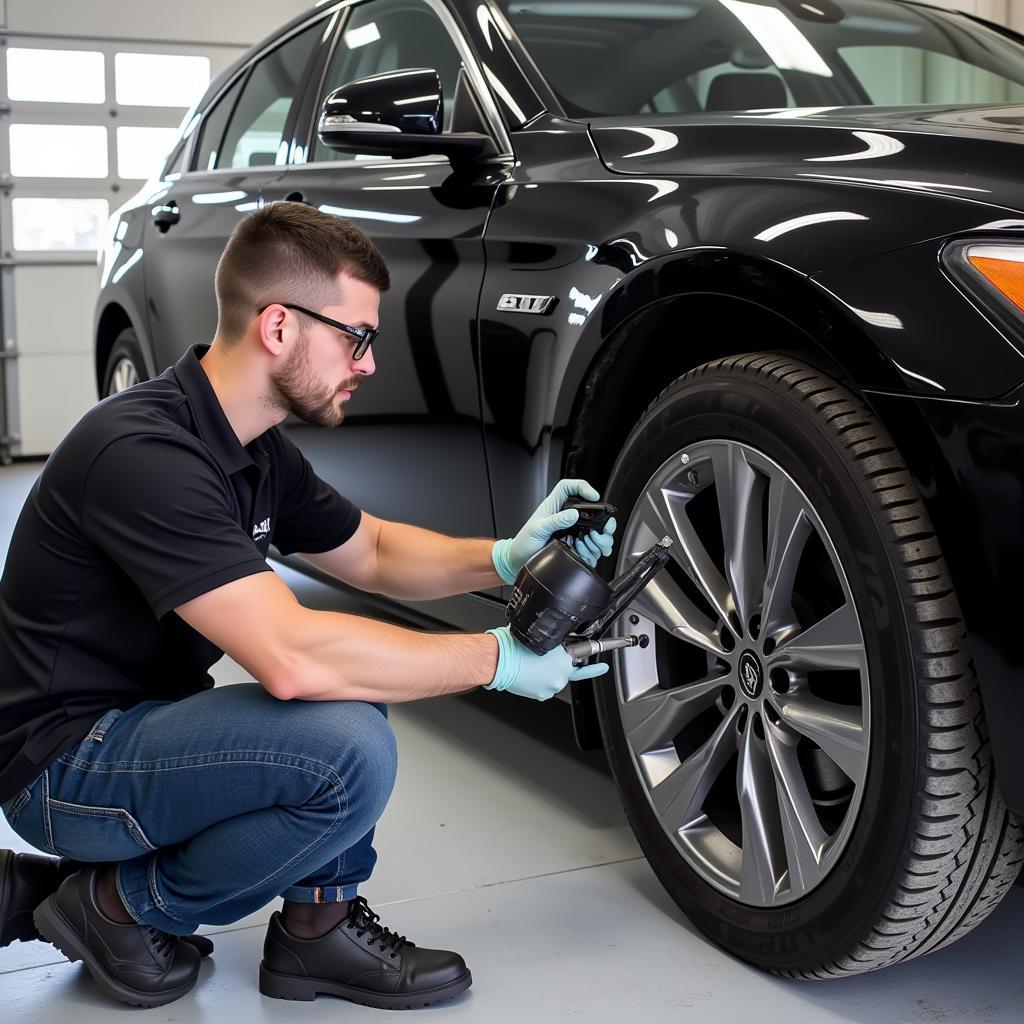Car Underbody Detailing is often overlooked, yet it’s a crucial aspect of vehicle maintenance that significantly impacts its longevity and resale value. Protecting your car’s undercarriage from the relentless assault of road salt, grime, and moisture is essential, and this comprehensive guide will delve into everything you need to know about car underbody detailing.
Why is Car Underbody Detailing Important?
Beyond aesthetics, car underbody detailing plays a vital role in preserving your vehicle’s structural integrity. The undercarriage is constantly exposed to harsh elements that can cause rust, corrosion, and ultimately, expensive repairs. Regular detailing helps prevent these issues, safeguarding your investment and ensuring a smoother, safer ride. Think of it as preventative medicine for your car.
Protecting Against Corrosion
Rust is the enemy of any vehicle. The underbody, being closest to the road, is particularly vulnerable. Car underbody detailing involves cleaning, prepping, and applying protective coatings that shield the metal from moisture and corrosive agents like road salt. This proactive approach can save you thousands in future repairs.
Enhancing Vehicle Longevity
By preventing rust and corrosion, car underbody detailing significantly extends the life of your vehicle. A well-maintained undercarriage translates to a healthier car overall, contributing to its long-term performance and reliability.
Maintaining Resale Value
A clean and protected underbody is a strong selling point. When it comes time to trade in or sell your car, a rust-free undercarriage will undoubtedly impress potential buyers, maximizing its resale value.
 Car Underbody Detailing for Rust Prevention
Car Underbody Detailing for Rust Prevention
The Car Underbody Detailing Process
Car underbody detailing is a meticulous process that involves several key steps:
- Thorough Cleaning: This involves removing loose dirt, debris, and grime using specialized cleaning solutions and pressure washers.
- Rust Removal: Existing rust is addressed using rust removers or mechanical methods like sanding or wire brushing.
- Surface Preparation: The undercarriage is thoroughly dried and degreased to ensure proper adhesion of the protective coating.
- Protective Coating Application: A specialized undercoating or rustproofing agent is applied to create a barrier against the elements.
Choosing the Right Undercoating
Several types of undercoating are available, each with its own benefits and drawbacks. Common options include rubberized undercoating, asphalt-based undercoating, and wax-based undercoating. Consulting a professional detailer can help you choose the best option for your specific needs and driving conditions.
DIY vs. Professional Car Underbody Detailing
While some car owners opt for the DIY approach, professional car underbody detailing offers several advantages. Professionals have the expertise, equipment, and access to high-quality products to achieve optimal results. They can also identify potential issues early on, preventing further damage and saving you money in the long run.
 Professional Car Underbody Detailing Process
Professional Car Underbody Detailing Process
How Often Should You Detail Your Car’s Underbody?
The frequency of car underbody detailing depends on various factors, including your driving conditions and the climate you live in. Areas with harsh winters and frequent road salt application require more frequent detailing, ideally annually or even bi-annually. In milder climates, detailing every two to three years might suffice.
Signs Your Car Needs Underbody Detailing
- Visible rust or corrosion
- Peeling or flaking undercoating
- Excessive road noise
- Reduced fuel efficiency
Maintaining Your Underbody After Detailing
After your car’s underbody has been detailed, proper maintenance is essential to prolong the life of the protective coating. Regularly rinsing the undercarriage, especially after driving in harsh conditions, can help remove debris and prevent buildup.
Conclusion
Car underbody detailing is a vital investment in your vehicle’s health and longevity. By protecting the undercarriage from the elements, you can prevent costly repairs, enhance performance, and maintain resale value. Whether you choose the DIY route or opt for professional service, regular car underbody detailing is a crucial part of responsible car ownership.
FAQ
- How much does car underbody detailing cost? The cost varies depending on the size of your vehicle and the type of coating used, but typically ranges from $100 to $300.
- Can I detail my car’s underbody myself? While possible, professional detailing is recommended for optimal results.
- What is the best type of undercoating? The best type depends on your driving conditions and climate. Consult a professional for personalized advice.
- How long does undercoating last? Depending on the type and quality of the coating, it can last anywhere from two to five years.
- Is car underbody detailing necessary for new cars? While not immediately essential, it’s a worthwhile investment to protect your new car from day one.
- How can I prevent rust on my car’s underbody? Regular cleaning and application of a protective coating are the best ways to prevent rust.
- What are the signs of a rusty undercarriage? Visible rust, flaking paint, and unusual noises are common signs.
Common Car Underbody Detailing Questions
- What if I already have rust on my undercarriage? A professional detailer can remove existing rust before applying a protective coating.
- Is it safe to drive my car immediately after undercoating? Yes, most undercoatings dry quickly and allow for immediate driving.
Further Reading
Explore more car detailing tips and advice on our website. Learn about paint correction, interior detailing, and other services to keep your car looking its best.
Need assistance? Contact us via WhatsApp: +1(641)206-8880, Email: [email protected]. Our customer service team is available 24/7.

Leave a Reply